Hello, wonderful readers! 🌸 Imagine walking into a temple where every wall seems alive where gods, dancers, flowers, and ancient tales burst out from the stone itself. That’s the magic of Lepakshi, a small town in Andhra Pradesh that has quietly guarded one of India’s most fascinating art treasures the Lepakshi Murals.
These murals aren’t just paintings; they’re vibrant storytellers that have spoken for centuries without uttering a word. Every curve, color, and figure carved or painted on these walls whispers something about India’s golden past its devotion, artistry, and imagination. Step inside the Veerabhadra Temple, and you’ll find ceilings covered with breathtaking frescoes, where divine stories unfold through reds, yellows, and greens made from natural pigments.
So, come along on this colorful journey through Lepakshi, where stones don’t just stand still they sing, dance, and tell stories that have lived for more than 400 years! 🎨✨
Historical Roots: The Birth of Lepakshi’s Timeless Art
Let’s take a step back in time to the 16th century, when art and devotion walked hand in hand in South India. The small town of Lepakshi, nestled in Andhra Pradesh, became the canvas of creativity during the glorious Vijayanagara Empire. Under the patronage of King Achyuta Deva Raya, two brothers, Viranna and Virupanna, devoted temple officers, brought to life one of India’s finest architectural and artistic wonders the Lepakshi Temple, also known as the Veerabhadra Temple.
What makes Lepakshi so fascinating is how its walls and ceilings were transformed into storybooks of stone and color. The artists didn’t just paint they told stories of gods, dancers, and celestial beings. Each mural whispers tales from the Ramayana, Mahabharata, and Puranas, painted using natural pigments and brushes made from local materials.
These murals, sprawling across more than 600 square meters, reflect not just divine tales but the spirit of the Vijayanagara era, a time when creativity flourished alongside faith. Every brushstroke was a prayer, every hue a celebration. The Lepakshi murals aren’t just art they are the echoes of a civilization that believed stories could live forever on stone.
Materials and Techniques: The Earthy Palette of Lepakshi
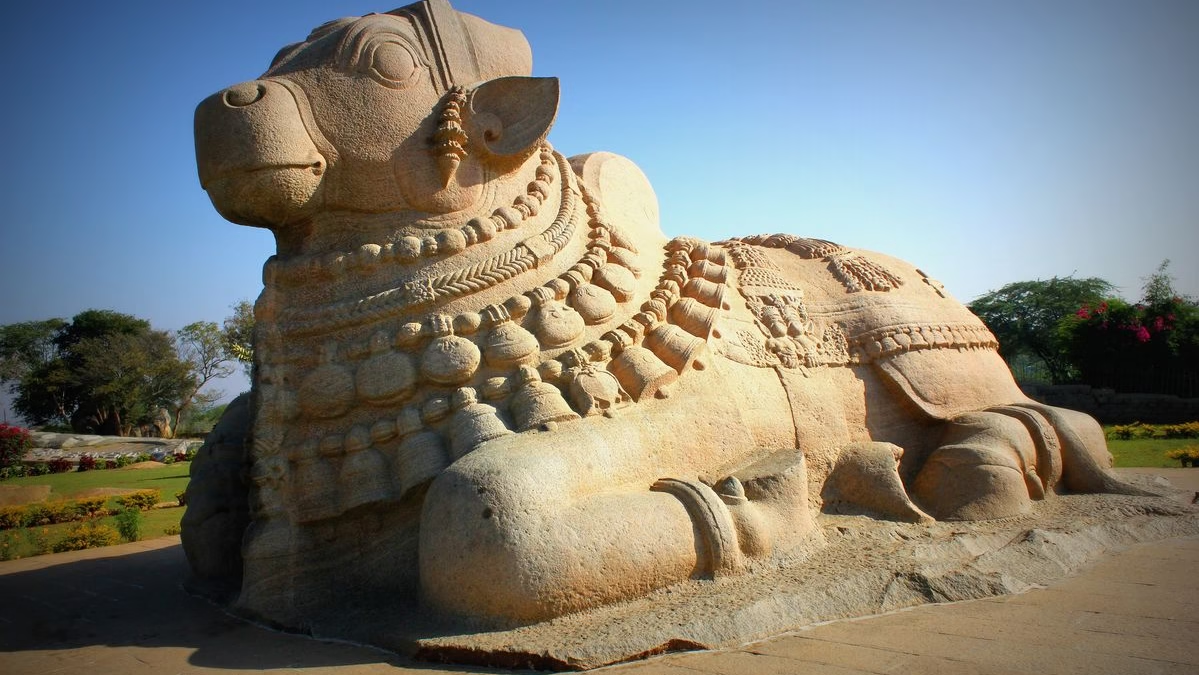
The Lepakshi murals are not just paintings they are timeless stories etched in color and stone, reflecting devotion, culture, and artistic brilliance. What makes them so mesmerizing is the unique combination of materials and techniques used by the artisans centuries ago. Let’s explore how these masterpieces come to life.
🌿 Natural Materials: Colors from the Earth
- Mineral Pigments
- Artists extracted pigments directly from rocks and minerals.
- Red came from red ochre, yellow from yellow ochre, and black from charcoal.
- These natural colors have stood the test of time, retaining their vibrancy for centuries.
- Artists extracted pigments directly from rocks and minerals.
- Plant-Based Colors
- Certain shades, especially green and blue, were derived from leaves, roots, and flowers.
- Indigo, turmeric, and other organic dyes added subtle, earthy tones.
- Certain shades, especially green and blue, were derived from leaves, roots, and flowers.
- Lime Plaster Base
- The walls were coated with a fine layer of lime plaster before painting.
- This smooth base allowed the pigments to bind better and gave the murals their long-lasting durability.
- The walls were coated with a fine layer of lime plaster before painting.
🖌 Techniques: Bringing Stones to Life
- Fresco Method
- Artists applied pigments directly onto wet lime plaster so the colors fused naturally as the wall dried.
- This technique made the murals resistant to fading and weathering.
- Artists applied pigments directly onto wet lime plaster so the colors fused naturally as the wall dried.
- Layering and Shading
- Multiple layers of color were applied to create depth and dimension.
- Shading highlighted facial expressions, folds in clothing, and the intricate details of jewelry.
- Multiple layers of color were applied to create depth and dimension.
- Fine Detailing with Brushes
- Brushes made from animal hair or plant fibers helped create sharp outlines and delicate patterns.
- Every figure, animal, and ornament was carefully crafted to narrate a story.
- Brushes made from animal hair or plant fibers helped create sharp outlines and delicate patterns.
✨ Why Materials and Techniques Matter
- Longevity: Natural pigments and lime plaster have preserved the murals for over 500 years.
- Visual Impact: The earthy tones blend perfectly with the stone architecture, giving a harmonious and sacred feel.
- Cultural Significance: Every color and stroke reflects local beliefs, rituals, and artistic traditions.
In essence, the earthy palette of Lepakshi is a testimony to the skill, patience, and vision of artists who turned simple walls into vivid storytelling canvases that continue to awe visitors today.
The Making Process: How Artists Brought Stones to Life
The murals of Lepakshi are not just paintings; they are living stories etched onto temple walls, capturing mythology, devotion, and culture. The process of creating these murals was as detailed and artistic as the final masterpiece itself. Let’s explore how skilled artisans brought stones to life:
1. Preparing the Canvas: Temple Walls
- Selecting the Surface: Artists chose freshly plastered walls of temples and pillars, which were smooth and slightly moist to hold the pigment.
- Lime Plaster Application: Multiple layers of lime plaster mixed with sand created a strong base. This also helped the pigments adhere properly and ensured durability.
- Smoothing and Polishing: Before painting, walls were polished to remove uneven textures, providing a flawless canvas for the mural.
2. Sketching the Story
- Preliminary Outlines: Artists sketched designs lightly using charcoal or red ochre.
- Guided by Mythology: Every sketch was rooted in religious tales—like episodes from the Ramayana and Puranas.
- Proportional Precision: Figures were drawn using basic ratios to maintain consistency, whether depicting humans, animals, or divine beings.
3. Applying Natural Pigments
- Colors from Nature: Earthy reds, yellows, blues, and greens were extracted from minerals, stones, and plants.
- Layering Technique: Each color was applied in layers, starting from lighter shades and finishing with darker details.
- Detailing Faces and Expressions: Tiny brushes and fingertips were used to bring emotion and life to characters.
4. Finishing Touches and Highlights
- Gold and White Accents: Some murals included fine white lines and touches of gold for divine aura and emphasis.
- Texture and Depth: Shadows and highlights were added to give a three-dimensional feel.
- Final Seal: A thin coating of natural varnish or lime wash was sometimes applied to protect the colors from weathering.
Symbols and Motifs: Hidden Meanings Behind Every Stroke
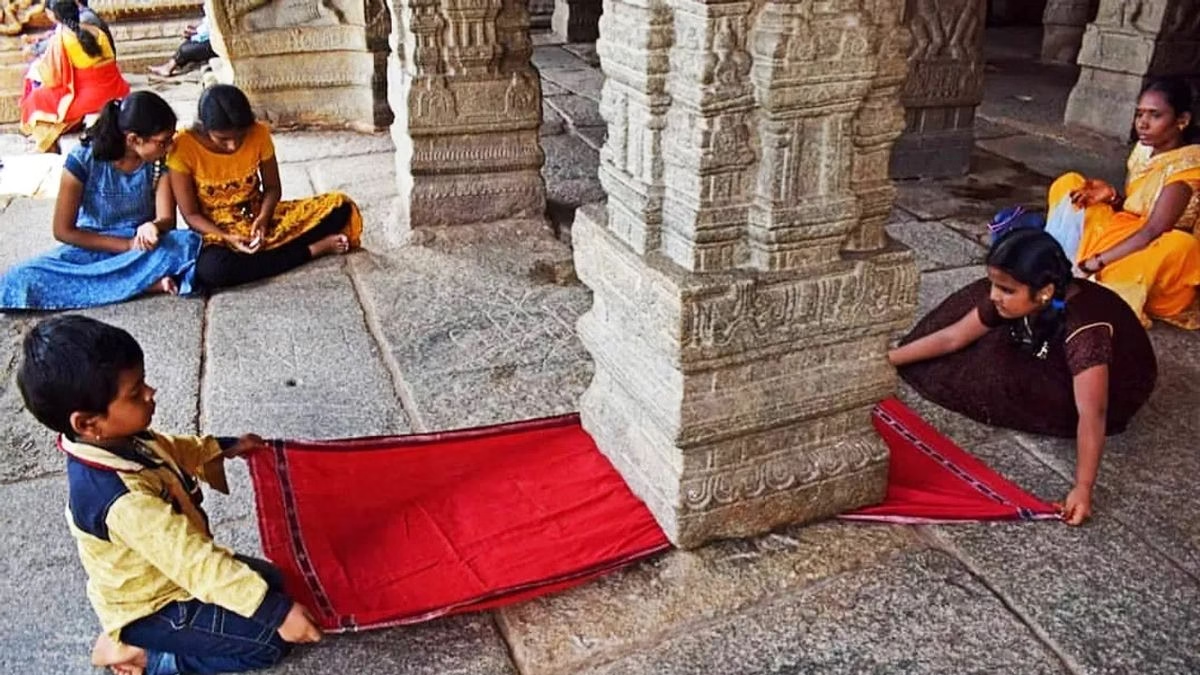
Lepakshi murals are not just colorful paintings—they are visual stories etched in stone, each brushstroke carrying centuries of culture, devotion, and artistic symbolism. Let’s explore the fascinating symbols and motifs that make these murals so captivating.
1. Divine Figures and Deities
- Lord Veerabhadra
- The most prominent deity in Lepakshi murals, often depicted with multiple arms and fierce expressions.
- Symbolizes strength, courage, and protection.
- His posture and weapons tell stories of mythological battles and moral lessons.
- The most prominent deity in Lepakshi murals, often depicted with multiple arms and fierce expressions.
- Lord Shiva and Parvati
- Scenes of Shiva and Parvati depict harmony, devotion, and cosmic balance.
- These motifs remind viewers of the spiritual essence behind temple rituals.
- Scenes of Shiva and Parvati depict harmony, devotion, and cosmic balance.
- Other Gods and Goddesses
- Vishnu, Lakshmi, and regional deities appear in smaller panels.
- Their presence in murals represents prosperity, protection, and blessings for devotees.
- Vishnu, Lakshmi, and regional deities appear in smaller panels.
2. Mythological Narratives
- Ramayana Episodes
- Several murals narrate episodes from the Ramayana, such as Hanuman lifting mountains or Ravana in battle.
- These images symbolize virtue triumphing over evil.
- Several murals narrate episodes from the Ramayana, such as Hanuman lifting mountains or Ravana in battle.
- Epic Battles and Legends
- Murals often capture dramatic moments, frozen in time through bold lines and colors.
- They teach lessons about courage, loyalty, and dharma (righteousness).
- Murals often capture dramatic moments, frozen in time through bold lines and colors.
3. Nature-Inspired Motifs
- Floral Designs
- Flowers, vines, and lotus patterns adorn borders and backgrounds.
- They symbolize purity, growth, and divine beauty, enhancing the spiritual ambiance of the temple.
- Flowers, vines, and lotus patterns adorn borders and backgrounds.
- Animals and Birds
- Elephants, peacocks, and swans appear frequently.
- Elephants symbolize strength and wisdom; peacocks represent beauty and grace; swans reflect purity and spiritual knowledge.
- Elephants, peacocks, and swans appear frequently.
- Celestial Symbols
- Sun, moon, and stars often accompany deities or battle scenes.
- These elements indicate cosmic harmony and the divine rhythm of life.
- Sun, moon, and stars often accompany deities or battle scenes.
4. Geometric and Abstract Patterns
- Repeating Borders and Lines
- Zigzags, chevrons, and grids form decorative yet symbolic borders.
- They provide balance and structure to the mural, reflecting order in chaos.
- Zigzags, chevrons, and grids form decorative yet symbolic borders.
- Sacred Geometry
- Circles, mandalas, and concentric patterns appear around divine figures.
- These motifs symbolize eternity, unity, and spiritual focus.
- Circles, mandalas, and concentric patterns appear around divine figures.
5. Cultural and Daily Life Symbols
- Musical Instruments
- Murals depict veenas, drums, and other instruments played by celestial beings or dancers.
- Represents celebration, art, and cultural prosperity.
- Murals depict veenas, drums, and other instruments played by celestial beings or dancers.
- Festivities and Dancers
- Scenes of folk dances, festivals, and processions are common.
- Highlight the temple’s role as a center of both spirituality and community life.
- Scenes of folk dances, festivals, and processions are common.
6. The Hidden Message
- Beyond Decoration
- Each motif in Lepakshi murals conveys a moral, spiritual, or cultural lesson.
- The combination of divine, natural, and geometric motifs creates a visual scripture on the temple walls.
- Each motif in Lepakshi murals conveys a moral, spiritual, or cultural lesson.
- Connecting Past and Present
- These symbols are more than art—they are a bridge connecting modern viewers to ancient beliefs, traditions, and storytelling methods.
🏛️ Architectural Harmony: How Murals Blend with Temple Design?
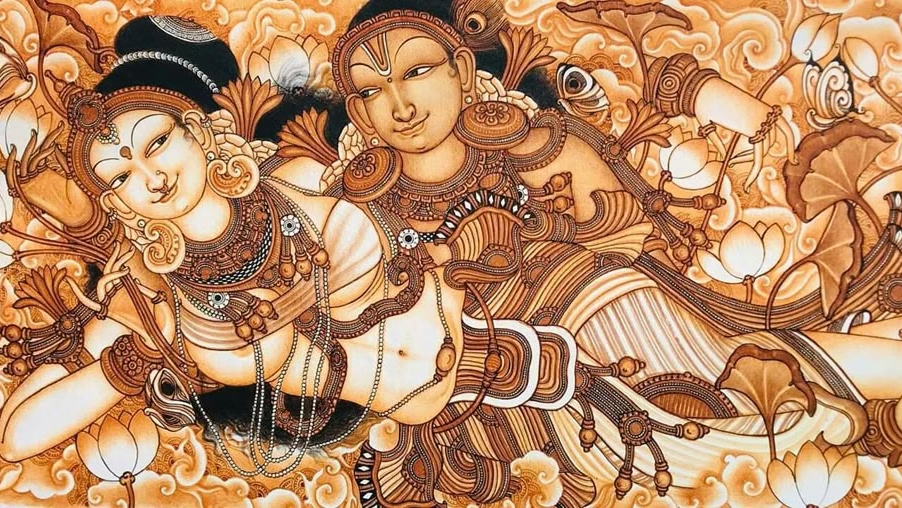
- The Lepakshi Murals are not just decorations on temple walls—they are the very soul of the structure.
- Every inch of the Lepakshi Temple, built during the Vijayanagara Empire, was designed with the idea that art and architecture must breathe together.
- The temple’s pillars, ceilings, and corridors were created as living canvases, where stone and color merge seamlessly.
🎨 Placement with Purpose
- The murals are strategically painted on ceilings, beams, and walls to guide the devotee’s eyes upward—toward the divine.
- Each hall, from the Ardha Mandapa (half hall) to the Kalyana Mandapa (wedding hall), carries scenes that match the purpose of that space.
- For example, the ceiling murals in the Kalyana Mandapa depict the celestial marriage of Shiva and Parvati, celebrating sacred union.
- In corridors, long processional murals show mythological stories, symbolizing the journey of the soul.
- For example, the ceiling murals in the Kalyana Mandapa depict the celestial marriage of Shiva and Parvati, celebrating sacred union.
- This careful placement creates a rhythmic connection between devotion, architecture, and storytelling.
🏺 Design that Breathes with Light
- The Lepakshi Murals were painted using natural light that streamed through carved openings and courtyards.
- Artists designed the compositions so that sunlight would highlight certain scenes during specific times of the day—almost like nature itself became part of the artwork.
- The shadows on sculpted pillars often align beautifully with the murals beside them, making the temple feel alive and ever-changing.
🔱 Artistic Symmetry and Balance
- The layout of the murals mirrors the architectural symmetry of the temple.
- Geometric borders and floral motifs frame divine figures in perfect proportion to the columns and arches they adorn.
- This harmony ensures that the Lepakshi Murals never feel added on—they grow naturally out of the temple’s stone skeleton.
🎨 Art in Numbers: Fascinating Facts and Statistics of Lepakshi Murals
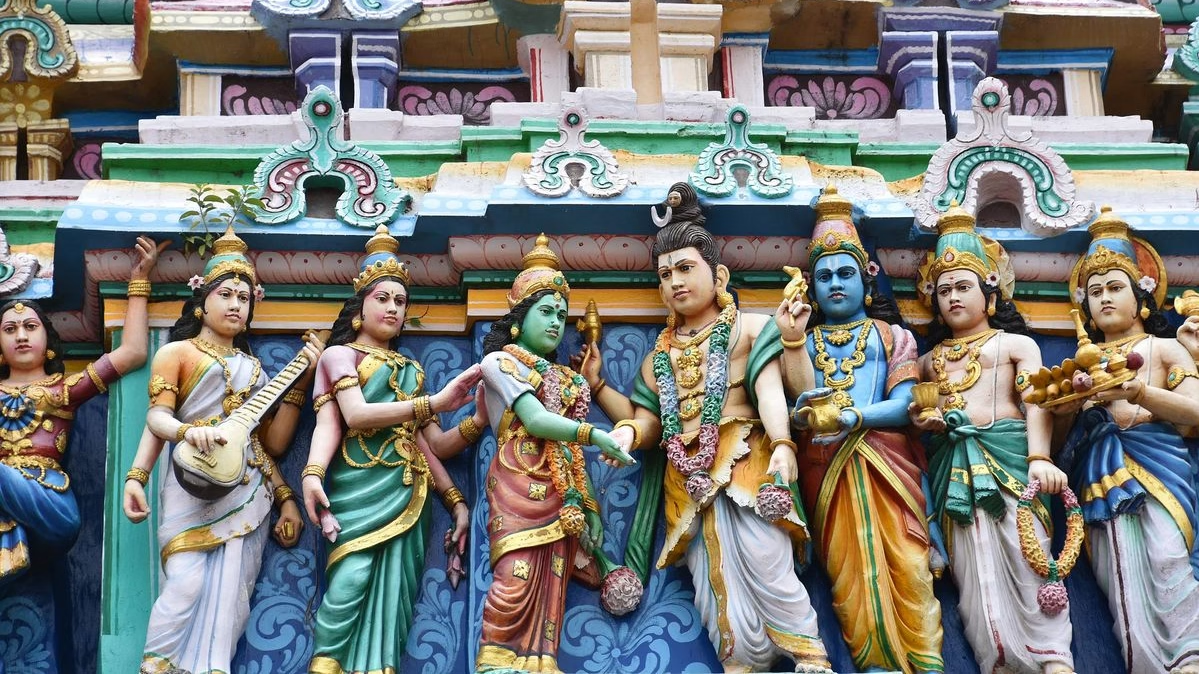
When you step inside the Lepakshi Temple, every wall, pillar, and ceiling whispers stories — but these stories aren’t just artistic; they’re numerical wonders too! Let’s uncover some fascinating facts and figures that make the Lepakshi Murals a true masterpiece of scale, precision, and imagination.
🏛️ 1. The Magnificent Scale of Lepakshi Murals
- The Lepakshi Murals spread across over 600 square meters of temple walls and ceilings — one of the largest mural collections in South India.
- The ceiling of the Natya Mandapa (Dance Hall) alone houses paintings stretching about 23 feet long, depicting stories from the Ramayana, Mahabharata, and Puranas.
- Some single panels of art measure nearly 15 feet by 8 feet, a breathtaking canvas of ancient storytelling.
🎨 2. The Color Story — Natural, Yet Vibrant
- Artists used 100% natural pigments made from plants, minerals, and crushed stones.
- The main shades — red ochre, indigo, yellow, black, and white — were prepared through meticulous grinding and layering techniques.
- Even after five centuries, the colors of the Lepakshi Murals remain vibrant, proving the brilliance of traditional Indian craftsmanship.
🧱 3. Craftsmanship and Time
- Each mural panel was hand-painted on lime-coated plaster, applied over granite walls — an incredibly difficult surface to master.
- Historians estimate that creating the entire mural series took more than 10 years, involving teams of expert painters and temple architects.
- The intricate linework shows the steady hand of artisans who could draw perfect circles and curves without modern tools.
🌟 4. Legacy by the Numbers
- The Lepakshi Murals date back to the 16th century Vijayanagara Empire and remain over 450 years old.
- More than 70 mural scenes narrate epics, dances, celestial beings, and daily life of that era.
- Today, the temple attracts thousands of visitors every year, including historians, artists, and students of architecture.
🕊️ Preservation and Legacy: Keeping the Ancient Colors Alive
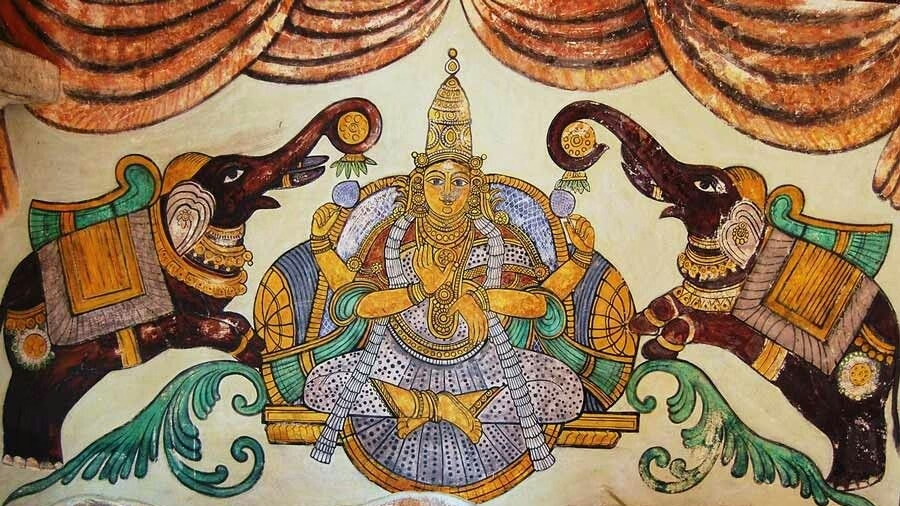
🌿 Fading Beauty, Eternal Spirit
- The Lepakshi Murals, once glowing with natural reds, yellows, and blues, are now slowly fading due to time, humidity, and neglect.
- Yet, each wall still holds the whispers of ancient tales — waiting for modern hands to protect their voice.
🛕 Efforts to Conserve the Glory
- The Archaeological Survey of India (ASI) has taken charge of conserving the Lepakshi Temple complex, carefully cleaning, repairing, and stabilizing damaged mural sections.
- Experts use natural-friendly restoration materials to ensure the original colors and texture of the murals remain intact.
- Regular humidity checks and protective coatings are now helping to slow down deterioration.
🌈 Passing on the Legacy
- Art schools and heritage programs are introducing young artists to the story of Lepakshi Murals, encouraging them to study and recreate the traditional painting style.
- Local artisans are also reviving motifs from these murals in handicrafts and textiles — keeping the spirit of Lepakshi alive in modern art forms.
Conclusion
In the end, Lepakshi Murals stand as more than just paintings on stone—they are living stories frozen in time. Every brushstroke, color, and curve echoes devotion, imagination, and the unmatched skill of ancient artisans.
These murals are a silent dialogue between art and faith, between history and the present. As we walk beneath their painted ceilings, we aren’t just admiring art; we’re witnessing India’s soul unfold through stone and color. Lepakshi Murals remind us that true storytelling doesn’t always need words—sometimes, it breathes quietly through walls that have seen centuries pass.
Also read: Gond Painting : A Traditional Art From Madhya Pradesh

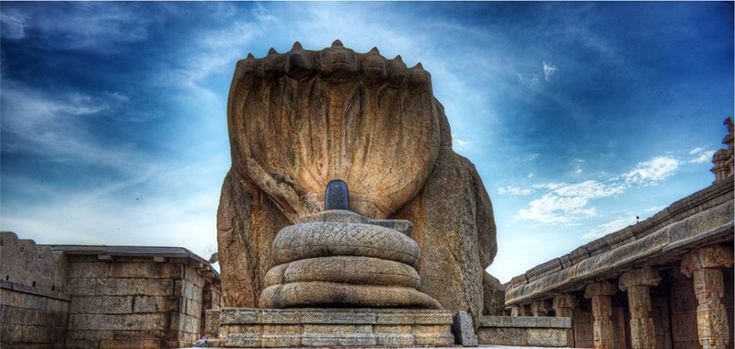
Leave a Reply